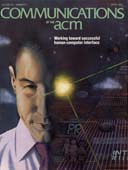April 1983 - Vol. 26 No. 4

Features
Error messages: the neglected area of the man/machine interface
The quality of error messages produced by software used in the field was tested by a simple experiment; it was found to be far from adequate. The results of the experiment are analyzed, and some responses which tend to collaborate the original findings are discussed. Finally, some suggestions are made for improving the quality of error messages.
This paper presents an efficient algorithm based on Quicksort. The Quicksort algorithm is known to be one of the most efficient sorting techniques; however, one of the drawbacks of this method is its worst case situation of 0 (n2) comparisons. The algorithm presented here improves the average behavior of Quicksort and reduces the occurrence of worst case situations.
3~
Design rules based on analyses of human error
By analyzing the classes of errors that people make with systems, it is possible to develop principles of system design that minimize both the occurrence of error and the effects. This paper demonstrates some of these principles through the analysis of one class of errors: slips of action. Slips are defined to be situations in which the user's intention was proper, but the results did not conform to that intention. Many properties of existing systems are conducive to slips; from the classification of these errors, some procedures to minimize the occurrence of slips are developed.
Using formal specifications in the design of a human-computer interface
Formal specification techniques are valuable in software development because they permit a designer to describe the external behavior of a system precisely without specifying its internal implementation. Although formal specifications have been applied to many areas of software systems, they have not been widely used for specifying user interfaces. In the Military Message System project at the Naval Research Laboratory, the user interfaces as well as the other components of a family of message systems are specified formally, and prototypes are then implemented from the specifications. This paper illustrates the specification of the user interface module for the family of message systems. It then surveys specification techniques that can be applied to human-computer interfaces and divides the techniques into two categories: those based on state transition diagrams and those based on BNF. Examples of both types of specifications are given. Specification notations based on state transition diagrams are preferable to those based on BNF because the former capture the surface structure of the user interface more perspicuously. In either notation, a high-level abstraction for describing the semantics of the user interface is needed, and an application-specific one is used here.
The evaluation of text editors: methodology and empirical results.
This paper presents a methodology for evaluating text editors on several dimensions: the time it takes experts to perform basic editing tasks, the time experts spend making and correcting errors, the rate at which novices learn to perform basic editing tasks, and the functionality of editors over more complex tasks. Time, errors, and learning are measured experimentally; functionality is measured analytically; time is also calculated analytically. The methodology has thus far been used to evaluate nine diverse text editors, producing an initial database of performance results. The database is used to tell us not only about the editors but also about the users—the magnitude of individual differences and the factors affecting novice learning.
Job and health implications of VDT use: initial results of the Wisconsin-NIOSH study
Magnitudes and correlates of stress were investigated among 248 office workplace VDT users and 85 nonuser counterparts using field survey and objective physical measurement techniques. Other than a tenuous indication of increased eyestrain and reduced psychological disturbances among users, the two groups were largely undifferentiated on job-attitudinal, affective, and somatic manifestations of stress. However, aspects of working conditions were judged less favorably by VDT users. Stress mechanisms were much the same for both groups, involving psychosocial as well as physical environmental job attributes. For VDT users, the chair and workstation configuration were particularly important predictors of musculo-skeletal disturbances, as were corrective eyewear use and ambient lighting for visuo-ocular disturbances.
Composing letters with a simulated listening typewriter
With a listening typewriter, what an author says would be automatically recognized and displayed in front of him or her. However, speech recognition is not yet advanced enough to provide people with a reliable listening typewriter. An aim of our experiments was to determine if an imperfect listening typewriter would be useful for composing letters. Participants dictated letters, either in isolated words or in consecutive word speech. They did this with simulations of listening typewriters that recognized either a limited vocabulary (1000 or 5000 words)or an unlimited vocabulary. Results suggest that some versions, even upon first using them, could be at least as good as traditional methods of handwriting and dictating. Isolated word speech with large vocabularies may provide the basis for a useful listening typewriter.



